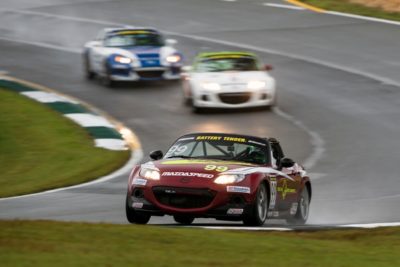Number 1 in a countdown of the top 10 things a racer must do to be successful in climbing the motorsport ladder: Find partners and sponsors to keep your climb going.
Like it or not, racing takes money. There are no scholastic leagues where you play for free and recruiters come looking for talent. Teams are as interested in your value proposition as they are your skills. If you want to keep climbing the motorsports ladder, you will need partners to do it.
“Any team owner you go to, whether it’s IndyCar, NASCAR or sports cars, they’re going to be as interested in your value package as they are your racing résumé,” says Jim Bowie, who handles much of Mazda Motorsports’ marketing efforts via his role with Brandrenaline, Inc., the Agency of Record, Partnership Programs, Mazda Motorsports. “What can you bring from a value standpoint? It’s not a matter of walking up and saying, ‘I’ve won 12 championships.’ If you have, they probably know who you are. It’s more about, ‘I have these other value propositions.’”
Those “other value propositions” are partnerships. Many racers see that as another word for “sponsors,” but Bowie makes a distinction between the two.
“Don’t look for sponsors, because everybody ‘sponsors.’ If you’re looking for sponsors, look out the window. The dry cleaner that you take your suit to – they sponsor the little league baseball team. So you don’t look for sponsors, you look for value. What that means is if you have struck up a relationship with company X that makes widgets, and all of a sudden you see company Y that buys widgets, and you can put that together through motorsport, that’s a way to get a sponsor, by staying alert and looking for value.”
One suggestion Bowie has is to look at the entry list, look at who the partners are, walk through the paddock, look at the logos on every car and consider if there is anybody there that their existing partners can do business with. But it also doesn’t have to be someone already in the paddock. The real trick is bringing someone from outside, showing them the value in motorsports and perhaps forming a lifelong partnership. Bowie did a seminar for the Mazda Road to Indy drivers, in Indy in May, and discussed just such a proposition.
“Because we were in the state of Indiana, in Indianapolis, I woke up and I say, ‘I’m a race car driver, and I need funding. I need someone else’s money to go racing … what would I do?’ So I Google searched the ‘top 10 fastest-growing companies in Indiana’ and got a lot of results. I looked for high-growth companies, and companies that I can use racing to tell a story.
“There were law firms, but I can’t make a connection there. But I found a company that had over 4000 percent growth, went from 90 employees to 300 in two years, and it was in the logistics business. So I think about racing, and I think about the paddock, and I think about all this equipment, all these teams, all this stuff that comes from all over the world. It relies on a time-certain schedule – when the green flag goes, you’ve got to be ready. So it tells the perfect story for a logistics company. Then I built a program. I researched the company, I found out what charities they’re involved in, what their messaging was, what their key product attributes are, and I built a program that uses racing to tell that story.”
It sounds like a lot of work – and it is. And the hard part – the reaching out, the getting the key players to an event and showing them how they can use the assets of racing and give them a return on their investment – is only beginning. But it’s not about guaranteeing future championships and asking for money; a driver has to show that return on investment.
These are all things a racing driver must think about as he or she is networking in the paddock – both the one they’re in and the ones they want to be in – is what kind of value do I bring, either to potential partners or potential teams. The whole purpose of networking is that people know who you are (they know the results of your on-track product – but they need to know, fundamentally, who you are). The more people you can introduce yourself to, the more people who can see potential value in you, the greater your chances of success.
In the end, what potential partners are looking for is value, and that’s the top thing in their mind. It should be the top thing in your mind as well.
Related Content:
Be the Complete Racer: Choices
Be the Complete Racer: Fitness
Be the Complete Racer: Study
Be the Complete Racer: Seat Time
Be the Complete Racer: Study at the Track
Be the Complete Racer: Build Your Brand
Be the Complete Racer: Don’t Skip Steps
Be the Complete Racer: Be a Professional
Be the Complete Racer: Be Mentally Tough


 ACCESSIBILITY
ACCESSIBILITY